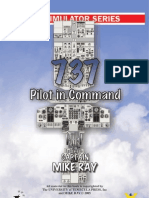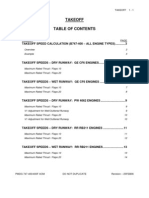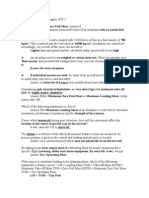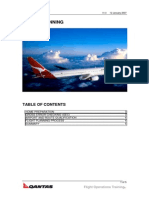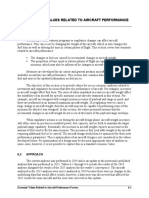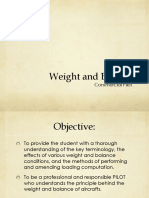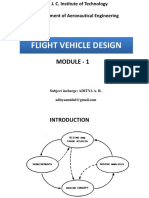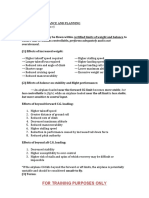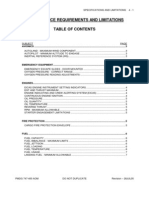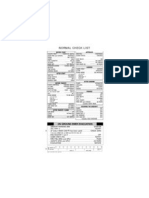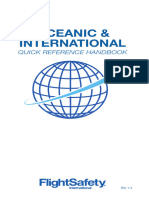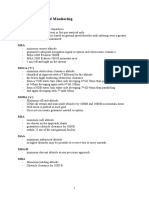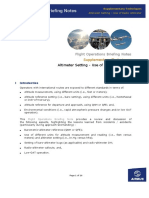02 Cruise Performance 747 400 v10
02 Cruise Performance 747 400 v10
Uploaded by
flightstudentCopyright:
Available Formats
02 Cruise Performance 747 400 v10
02 Cruise Performance 747 400 v10
Uploaded by
flightstudentCopyright
Available Formats
Share this document
Did you find this document useful?
Is this content inappropriate?
Copyright:
Available Formats
02 Cruise Performance 747 400 v10
02 Cruise Performance 747 400 v10
Uploaded by
flightstudentCopyright:
Available Formats
CRUISE and FUEL PLANNING 2 - 1
CRUISE TABLE OF CONTENTS
SUBJECT PAGE
CRUISE FLIGHT ..................................................................................................3
Overview .................................................................................................................................................... 3
FUEL PLANNING SCHEMATIC 747-400 ............................................................5
(STANDARD UNITS)............................................................................................................................... 5 (METRIC UNITS)...................................................................................................................................... 6
FUEL LOAD PLANNING......................................................................................7
(Standard Units) ......................................................................................................................................... 7 (Metric Units) ............................................................................................................................................. 8
FUEL REQUIRED TO REACH PLANNED ALTERNATE DESTINATION...........9
Landing Weight at Alternate x 1000lbs...................................................................................................... 9
CONTINGENCY FUEL .........................................................................................9 MAXIMUM & OPTIMUM CRUISE ALTITUDES ...................................................9
Optimum Wt............................................................................................................................................... 9 Time to Burn Fuel Wt Explained: .............................................................................................................. 9
GE-CF6 CRUISE PERFORMANCE TABLES ....................................................10 PW-4062 CRUISE PERFORMANCE TABLES ..................................................22 RR-RB211 CRUISE PERFORMANCE TABLES................................................32 GE-CF6 FLIGHT PLANNING CHARTS .............................................................42 PW-4062 FLIGHT PLANNING CHARTS ...........................................................46 RR-RB211 FLIGHT PLANNING CHARTS.........................................................50 FUEL PLANNING METHODOLOGY .................................................................54
Overview .................................................................................................................................................. 54 Determine Trip Length ............................................................................................................................. 54 Estimate Fuel Required ............................................................................................................................ 54 Refining Fuel Calculations ....................................................................................................................... 55 Step 1: Minimum Landing Fuel............................................................................................................ 55 Step 2: Alternate Fuel........................................................................................................................... 55 Step 3: Contingency Fuel ..................................................................................................................... 55 Step 4: Flight Plan Fuel ........................................................................................................................ 56 Step 5: Takeoff Weight......................................................................................................................... 57 Step 6: Determine Initial Cruise Altitude ............................................................................................. 57 FMC Fuel Management............................................................................................................................ 58
PMDG 747-400/400F AOM
DO NOT DUPLICATE
Revision 26FEB06
2-2
CRUISE and FUEL PLANNING
THIS PAGE INTENTIONALLY BLANK
Revision 26FEB06
DO NOT DUPLICATE
PMDG 747-400/400F AOM
CRUISE and FUEL PLANNING 2 - 3
CRUISE FLIGHT
Overview: Correct planning for cruise flight is extremely important for the safe and timely operation of any aircraft. This becomes particularly true when operating the 747-400. The tremendous range and endurance capabilities of the aircraft allow for transition through many different flight environments during a single operation and it is not uncommon for flight planning to occur fifteen to twenty hours prior to scheduled arrival at a destination airport. The time involved in long range flying may allow for significant changes in weather or ATC conditions during the course of a flight, so to ensure safe and consistent results, it is important that crews thoroughly understand the inter-relation of the variables involved in cruise flight planning. The three variables most directly affecting the aircrafts cruise flight performance are: Planned Landing Weight, Cruise Altitude and Cruise Speed. Increasing or decreasing any one of these variables may have a significant impact on fuel consumption and range capability of the aircraft. Proper determination of aircraft load weights combined with well thought out selection of flight level and Mach cruise speeds are integral to accurate performance planning. Definitions: Following are a number of definitions used in flight planning. Destination: The airport of intended landing for the flight. Alternate: The airport which has been selected by the crew as an alternate landing airport in case the Destination airport is unusable due to weather conditions, ATC or other factors. Basic Operating Weight: The weight of the aircraft minus any passengers, baggage, cargo or usable fuel. This weight figure includes items such as the weight of the aircraft structure, hydraulic fluid, air conditioning fluids, residual fuel, residual oil, crew, crew luggage, potable water, passenger accommodation fluids, and normal passenger service equipment normally carried on board. Payload: Weight of all passengers, bags or cargo to be carried aboard the aircraft during flight Zero Fuel Weight: The weight of the unfueled aircraft after all passengers, bags and cargo have been loaded. (BOW + Payload = ZFW) This number yields the weight of the aircraft prior to any useable fuel being loaded. Maximum Zero Fuel Weight: This is the heaviest weight allowed for the airplane before adding fuel weight. MZFW for this airplane as modeled is: 535,000lbs. Minimum Landing Fuel: This is the absolute minimum amount of fuel that will remain on the aircraft at the time the airplane lands. Specifically, this number represents the weight of usable fuel still remaining on board the aircraft in the worst case scenario. (E.g. the crew is forced to hold enroute, flies an approach to the destination followed by a missed approach, more holding, diverts to the alternate airport and lands.) The Minimum Landing Fuel for the 747-400 is normally 24,000lbs. If for any reason you expect to land with less than this amount of fuel, it should be considered an emergency condition. Alternate Fuel: The amount of fuel required to the aircraft from the Destination after a missed approach to the alternate airport. Contingency Fuel: Fuel boarded to allow for airborne holding, off optimum altitude flying, off optimum speed flying, or changes in the route of flight that might increase the fuel burn enroute. Flight Plan Fuel: This figure represents the fuel load which is required to fly the aircraft form the airport of origin to the airport of destination. This figure should be corrected for winds along the route (see later in this chapter) but does not account for holding, missed approaches or other inefficiencies.
PMDG 747-400/400F AOM
DO NOT DUPLICATE
Revision 26FEB06
2-4
CRUISE and FUEL PLANNING
Planned Landing Weight: This figure represents the weight of the aircraft upon touchdown at the destination airport. (Theoretically, this is the weight of the airplane in a perfect scenario, where the crew lands at the destination immediately without holding, missed approaches, etc. Thus it represents the highest potential weight of the aircraft upon landing.) This weight figure is a critical limitation that should be carefully examined to ensure that it does not exceed 630,000lbs. This weight is determined by adding: Minimum Landing Fuel Alternate Fuel Contingency Fuel Zero Fuel Weight ============= Planned Landing Weight
Maximum Gross Landing Weight: This figure denotes the maximum weight at which the aircraft may be allowed to land. This figure is a structural limit weight designed to prevent over-stressing of structural members within the aircraft. This airplane is modeled with a 630,000lb MGLW. Maximum Planned Takeoff Weight: Unlike Max Gross Takeoff Weight, this figure is a variable figure and changes with each flight. This weight limit can be caused by insufficient runway length at the departure airport, for example but most commonly is experienced on short flights when the airplane is carrying a large payload over a shorter range. For example, we know that the MGLW for the airplane can never be more than 630,000lbs. We also know that the maximum weight of the airplane before any fuel is loaded must not exceed 535,000lbs. If we are planning a flight with the MZFW at 535,000lbs, we must take care to ensure that we will land with 95,000lbs of fuel, or less. (535,000lbs + 95,000lbs = 630,000lbs) More information on how to determine Maximum Allowable Takeoff Weight is provided later in this chapter. Maximum Planned Landing Weight: This figure is a variable figure specific to each flight. This weight could be a limit factor caused by insufficient runway length at the destination airport, or high density altitude at the destination airport. Weight Restrictions: During flight planning, it is important that the aircraft weight is maintained within the parameters of Maximum Gross Landing Weight, Maximum Gross Takeoff Weight, and Maximum Taxi Weight. As the fuel planning schematic is being filled in, crews should verify weight compliance. If a maximum structural weight or maximum operational weight is exceeded, the crew should either consider reducing aircraft weight by removal of passengers or cargo. If passengers or cargo cannot be removed, a reduced fuel load should be boarded, with plans made for an en-route fuel stop.
This figure is one of the most important figures in your flight plan, as it will be used to determine nearly all other aspects of your cruise altitude, range and fuel load. (See examples later in the chapter!) Cruise Speed: The Mach speed selected for use during cruise. Mach cruise speed setting can have a significant impact on the fuel flow encountered during flight. Mach .80 is generally used for Long Range Cruise flight, while Mach .86 is considered a High Speed Cruise. Fuel increases dramatically with an increase in mach speed. Maximum Gross Taxi Weight: The maximum weight at which the aircraft may be dispatched for taxi. This is a structural limit weight which is determined by the manufacturer to prevent over-stressing structural members within the aircraft. This airplane is modeled with an 877,000lb MGTW. Maximum Gross Takeoff Weight: This figure denotes the maximum weight at which the aircraft may be allowed to commence the takeoff roll. This figure is a structural limit weight designed to prevent overstressing of structural members within the aircraft. This airplane is modeled with an 875,000lb MTOW.
Revision 26FEB06
DO NOT DUPLICATE
PMDG 747-400/400F AOM
CRUISE and FUEL PLANNING 2 - 5
Fuel Planning Schematic 747-400
(STANDARD UNITS)
Basic Operating Empty Weight:
__394,000lbs__
Payload: ____________ Zero Fuel Weight: ____________
(Must be <= 535,000 on 400) (Must be <= 635,000 on 400F)
+ + +
Zero Fuel Weight: Minimum Landing Fuel: Alternate Fuel: Contingency Fuel: Planned Landing Weight:
____________ ____________ ____________ ____________ ____________
(Must be less than 630,000)
Planned Landing Weight: + Flight Plan Fuel: Planned Gross Takeoff Weight:
____________ ____________ ____________
(Must be <= 875,000 or Max Takeoff Weight Limit Calculated in TAKEOFF chapter!)
Planned Gross Takeoff Weight: + Taxi Fuel Burn Off: Planned Taxi-Out Weight:
____________ ____________ ____________
(Must be less than 877,000)
Schematic should be used to ensure compliance with structural weight limits. Crews should verify that planned takeoff and planned landing weights are not limited by reduced runway lengths or high density altitudes.
PMDG 747-400/400F AOM
DO NOT DUPLICATE
Revision 26FEB06
2-6
CRUISE and FUEL PLANNING
Fuel Planning Schematic 747-400
(METRIC UNITS)
Basic Operating Empty Weight:
__179,090kgs__
Payload: ____________ Zero Fuel Weight: ____________
(Must be <= 242,671kg on 400) (Must be <= 288,034kg on 400F)
+ + +
Zero Fuel Weight: Minimum Landing Fuel: Alternate Fuel: Contingency Fuel: Planned Landing Weight:
____________ ____________ ____________ ____________ ____________
(Must be less than 285,763kg)
Planned Landing Weight: + Flight Plan Fuel: Planned Gross Takeoff Weight:
____________ ____________ ____________
(Must be less than 397,727kg or Max Takeoff Weight Limit Calculated in TAKEOFF chapter!)
Planned Gross Takeoff Weight: + Taxi Fuel Burn Off: Planned Taxi-Out Weight:
____________ ____________ ____________
(Must be less than 398,636kg)
Schematic should be used to ensure compliance with structural weight limits. Crews should verify that planned takeoff and planned landing weights are not limited by reduced runway lengths or high density altitudes.
Revision 26FEB06
DO NOT DUPLICATE
PMDG 747-400/400F AOM
CRUISE and FUEL PLANNING 2 - 7
FUEL LOAD PLANNING
(Standard Units) DISTANCE: When Trip Length in Nautical Air Miles falls between levels on mileage scale, interpolate time and fuel required for trip. Example: 5400 NAM @ FL410 equals 11:15 and 230,000.
Table is based on following speed schedule: CLIMB: CRUISE: DESCENT: 250 KIAS to 10,000 feet; 300 KIAS to FL310; Mach .80 above FL310 M.86 at Optimum Altitude for aircraft weight (or step climb procedure) Mach .80 to FL340; 300 KIAS between FL340 and 10,000; 250KIAS below 10,000ft
WEIGHT:
Table is valid only for a planned landing weight of 475,000lbs. For every 10,000lbs deviation above (below) 475,000 lbs, add (subtract) fuel burnout correction shown in Adjust: row on bottom of table. Example: For 4800 NAM @ FL410 and 505,000lbs planned landing weight, fuel required would equal 198,000lbs + [(700lbs/hr x 3) x 10:00hrs] = 198,000lbs + 21,000lbs = 219,000lbs total fuel required.
Table Represents M.86 Cruise at Optimum Altitude (or use of Step Climb Procedures)
Trip Length NAM Pressure Altitude (Feet) / True Airspeed (Knots)
FL410 / 479
FL390 / 479 FL370 / 479 FL350 / 481 FL330 / 486 Flight Time (Hours:Minutes) and Fuel Burn (Pounds x 1000) 17:31 381.0 16:42 357.0 15:54 338.9 15:00 317.0 14:12 298.6 13:21 275.8 12:31 258.8 11:42 237.6 10:48 221.2 9:58 197.4 9:12 185.6 8:21 169.4 7:30 152.6 6:43 136.6 5:48 121.2 5:00 102.8 4:13 87.6 3:21 72.6 2:30 62.6 1:41 47.2 1:06 34.4 880lbs/hr 17:28 380.1 16:39 356.2 15:51 338.3 14:47 315.6 14:09 298.2 13:18 275.2 12:28 258.3 11:39 237.0 10:45 222.2 9:55 198.2 9:09 186.2 8:18 169.2 7:28 152.2 6:42 136.2 5:46 121.4 4:59 103.2 4:12 88.4 3:19 73.2 2:29 63.2 1:39 48.0 1:05 35.2 1000lbs/hr 17:22 378.8 16:33 355.2 15:46 336.9 14:42 315.4 14:05 297.4 13:13 274.6 12:23 257.5 11:35 239.2 10:41 224.0 9:51 200.0 9:06 188.0 8:15 171.8 7:25 155.0 6:40 139.0 5:44 124.0 4:57 105.6 4:10 90.4 3:18 75.0 2:28 64.6 1:39 48.8 1:05 35.6 860lbs/hr 17:20 386.0 16:30 362.0 15:42 344.0 14:38 321.0 14:01 303.0 13:09 280.0 12:19 260.7 11:31 244.0 10:37 230.0 9:47 206.0 9:03 200.0 8:13 176.4 7:23 170.4 6:38 169.8 5:42 128.4 4:56 108.4 4:08 93.6 3:18 77.6 2:26 66.4 1:37 50.0 1:04 36.0 680lbs/hr
FL310 / 488
8800 8400 8000 7600 7200 6800 6400 6000 5600 5200 4800 4400 4000 3600 3200 2800 2400 2000 1400 1000 800 400 Adjust:
17:31 380.0 16:43 356.0 15:54 338.0 15:02 316.0 14:12 298.0 13:22 275.0 12:31 258.0 11:43 238.0 10:48 222.0 10:00 198.0 9:12 186.0 8:21 169.0 7:30 152.0 6:43 136.0 5:48 121.0 5:00 103.0 4:13 88.0 3:21 73.0 2:30 62.0 1:41 46.5 1:06 34.0 700lbs/hr
16:23 381.0 15:35 353.0 14:31 331.0 13:54 313.0 13:03 390.2 12:13 270.9 11:25 254.0 10:32 240.0 9:42 215.0 8:57 210.6 8:08 184.4 7:20 167.4 6:35 176.4 5:39 134.2 4:53 113.4 4:05 97.7 3:15 80.8 2:22 69.0 1:34 51.6 1:00 36.8 320lbs/hr
PMDG 747-400/400F AOM
DO NOT DUPLICATE
Revision 26FEB06
2-8
CRUISE and FUEL PLANNING
FUEL LOAD PLANNING
(Metric Units) DISTANCE: When Trip Length in Nautical Air Miles falls between levels on mileage scale, interpolate time and fuel required for trip. Example: 5400 NAM @ FL410 equals 11:15 and 104,100kgs fuel.
Table is based on following speed schedule: CLIMB: CRUISE: DESCENT: 250 KIAS to 10,000 feet; 300 KIAS to FL310; Mach .80 above FL310 M.86 at Optimum Altitude for aircraft weight (or step climb procedure) Mach .80 to FL340; 300 KIAS between FL340 and 10,000; 250KIAS below 10,000ft
WEIGHT:
Table is valid only for a planned landing weight of 216,000Kgs. For every 4,500Kgs deviation above (below) 216,000 Kgs, add (subtract) fuel burnout correction shown in Adjust: row on bottom of table. Example: For 4800 NAM @ FL410 and 230,400kgs planned landing weight, fuel required would equal 89,800kgs + [(317Kg/hr x 3) x 10:00hrs] = 89,800kgs + 9,510kgs = 99,310kgs total fuel required.
Table Represents M.86 Cruise at Optimum Altitude (or use of Step Climb Procedures)
Trip Length NAM Pressure Altitude (Feet) / True Airspeed (Knots)
FL410 / 479
FL390 / 479 FL370 / 479 FL350 / 481 FL330 / 486 Flight Time (Hours:Minutes) and Fuel Burn (Kgs x 1000) 17:31 172.8 16:42 161.9 15:54 153.7 15:00 143.8 14:12 135.4 13:21 125.1 12:31 117.4 11:42 107.8 10:48 100.3 9:58 89.5 9:12 84.2 8:21 76.8 7:30 69.2 6:43 62.0 5:48 55.0 5:00 46.6 4:13 39.7 3:21 32.9 2:30 28.4 1:41 21.4 1:06 15.6 400kg/hr 17:28 172.4 16:39 161.6 15:51 153.4 14:47 143.2 14:09 135.3 13:18 124.8 12:28 117.2 11:39 107.5 10:45 100.8 9:55 89.9 9:09 84.5 8:18 76.8 7:28 69.0 6:42 61.8 5:46 55.1 4:59 46.8 4:12 40.1 3:19 33.2 2:29 28.7 1:39 21.8 1:05 16.0 454kg/hr 17:22 171.8 16:33 161.1 15:46 152.8 14:42 143.1 14:05 134.9 13:13 124.6 12:23 116.8 11:35 108.5 10:41 101.6 9:51 90.7 9:06 85.3 8:15 99.4 7:25 70.3 6:40 63.1 5:44 56.3 4:57 47.9 4:10 41.0 3:18 34.0 2:28 29.3 1:39 22.2 1:05 16.2 390kg/hr 17:20 175.1 16:30 164.2 15:42 156.0 14:38 145.6 14:01 137.4 13:09 127.0 12:19 118.3 11:31 110.7 10:37 104.3 9:47 93.4 9:03 90.7 8:13 80.0 7:23 77.3 6:38 77.0 5:42 58.2 4:56 49.2 4:08 42.5 3:18 35.2 2:26 30.1 1:37 22.7 1:04 16.3 308kg/hr
FL310 / 488
8800 8400 8000 7600 7200 6800 6400 6000 5600 5200 4800 4400 4000 3600 3200 2800 2400 2000 1400 1000 800 400 Adjust:
17:31 172.4 16:43 161.5 15:54 153.3 15:02 143.3 14:12 135.2 13:22 124.7 12:31 117.0 11:43 108.0 10:48 100.1 10:00 89.8 9:12 84.4 8:21 76.7 7:30 69.0 6:43 61.7 5:48 54.9 5:00 46.7 4:13 39.9 3:21 33.1 2:30 28.1 1:41 21.1 1:06 15.4 317kg/hr
16:23 172.8 15:35 160.1 14:31 150.1 13:54 142.0 13:03 177.0 12:13 122.9 11:25 115.2 10:32 108.9 9:42 97.5 8:57 95.5 8:08 83.6 7:20 75.9 6:35 80.0 5:39 60.9 4:53 51.4 4:05 44.3 3:15 36.7 2:22 31.3 1:34 23.4 1:00 16.7 145kg/hr
Revision 26FEB06
DO NOT DUPLICATE
PMDG 747-400/400F AOM
CRUISE and FUEL PLANNING 2 - 9
Fuel Required to Reach Planned Alternate Destination
Landing Weight at Alternate x 1000lbs NAM to Time to 430 lb to 475 lb 476 lb to 540 lb 541 lb to 630 lb Alternate Alternate [195kg to 215kg] [216kg to 245kg] [246kg to 285 kg] 100 0:30 6600lb [3000kg] 7200lb [3,300kg] 8000lb [3600kg] 200 0:41 11000lb [5000kg] 11600lb [5250kg] 13200lb [6000kg] 300 0:57 14000lb [6400kg] 15700lb [7100kg] 17200lb [7800kg] 400 1:10 17700lb [8000kg] 19800lb [9000kg] 21400lb [9700kg] 500 1:20 21000lb [9500kg] 22500lb [10200kg] 25400lb [11500kg] Based on Optimum Cruise Altitude Selection Table assumes an assured landing at planned alternate with only one approach flown.
Contingency Fuel
Contingency Fuel: In cases where the flight crew or dispatcher feels that they may encounter airborne holding while en-route, or may be required to fly at other than optimal speeds or altitudes, it may be beneficial to add contingency fuel to the desired fuel load. The amount of fuel boarded should reflect expectations in terms of total time to be spent in airborne holding both while en-route and during the approach phase of flight, and the amount of excess fuel burn that may be required by ATC forcing the aircraft off optimum altitudes and speeds..
Maximum & Optimum Cruise Altitudes
Altitude FL420 FL410 FL400 FL390 FL380 FL370 FL360 FL350 FL340 FL330 FL320 FL310 FL300 Optimum Wt 470,000lbs 500,000lbs 520,000lbs 550,000lbs 570,000lbs 600,000lbs 630,000lbs 670,000lbs 700,000lbs 740,000lbs 770,000lbs 810,000lbs 840,000lbs [213,000kg] [227,500kg] [238,000kg] [250,000kg] [247,500kg] [272,500kg] [285,000kg] [305,000kg] [315,000kg] [335,000kg] [350,000kg] [367,500kg] [385,000kg] Maximum Wt. 520,000lbs 550,000lbs 570,000lbs 600,000lbs 630,000lbs 670,000lbs 700,000lbs 740,000lbs 770,000lbs 810,000lbs 840,000lbs 870,000lbs [238,000kg] [250,000kg] [247,500kg] [272,500kg] [285,000kg] [305,000kg] [315,000kg] [335,000kg] [350,000kg] [367,500kg] [385,000kg] [395,000kg] Time to Burn Fuel Wt. 1:42 1:07 1:35 1:02 1:22 1:24 1:36 1:14 1:27 1:05 1:26 1:00
For purposes of flight planning, crews should plan to follow ICAO step climb procedures in order to most closely mimic a constant optimum altitude climb profile. This will provide for the most efficient fuel burn possible while working within the constraints of the ATC system. Time to Burn Fuel Wt Explained: The Time to Burn Fuel Weight column provides an estimate of how long it will take to burn into the next highest optimum flight level, given performance according to the Four Engine Mach .86 Cruise table. This information will allow crews to plan the time to be spent at each altitude, but can also be used to help estimate the highest altitude that can be reached during cruise flight of a known time duration. [Example: Takeoff at 770,000lbs for a six hour flight will yield an initial cruise altitude of FL320. After six hours of cruise flight, the optimum cruise altitude would be FL360.]
PMDG 747-400/400F AOM
DO NOT DUPLICATE
Revision 26FEB06
2 - 10
CRUISE and FUEL PLANNING
GE-CF6 Cruise Performance Tables
Long Range Cruise GE-CF6 Engine FL400 to FL450 300,000 to 400,000KG
Shaded Area represents approximate Optimum Altitude Profile.
Adjustments:
Increase/decrease N1 required by 1% per 5C above/below standard TAT. Increase/decrease fuel flow by 3% per 10C above/below standard TAT. Increase/decrease KTAS by 1 knot per 1C above/below standard TAT.
Max Cruise N1:
With engine anti-ice on subtract 1.9 With engine and wing anti-ice on subtract 3.7
Revision 26FEB06
DO NOT DUPLICATE
PMDG 747-400/400F AOM
CRUISE and FUEL PLANNING 2 - 11
Long Range Cruise GE-CF6 Engine FL400 to FL450 200,000 to 300,000KG
Shaded Area represents approximate Optimum Altitude Profile.
Adjustments:
Increase/decrease N1 required by 1% per 5C above/below standard TAT. Increase/decrease fuel flow by 3% per 10C above/below standard TAT. Increase/decrease KTAS by 1 knot per 1C above/below standard TAT.
Max Cruise N1:
With engine anti-ice on subtract 1.9 With engine and wing anti-ice on subtract 3.7
PMDG 747-400/400F AOM
DO NOT DUPLICATE
Revision 26FEB06
2 - 12
CRUISE and FUEL PLANNING
Long Range Cruise GE-CF6 Engine FL340 to FL390 300,000 to 400,000KG
Shaded Area represents approximate Optimum Altitude Profile.
Adjustments:
Increase/decrease N1 required by 1% per 5C above/below standard TAT. Increase/decrease fuel flow by 3% per 10C above/below standard TAT. Increase/decrease KTAS by 1 knot per 1C above/below standard TAT.
Max Cruise N1:
With engine anti-ice on subtract 1.5 With engine and wing anti-ice on subtract 2.9
Revision 26FEB06
DO NOT DUPLICATE
PMDG 747-400/400F AOM
CRUISE and FUEL PLANNING 2 - 13
Long Range Cruise GE-CF6 Engine FL340 to FL390 200,000 to 300,000KG
Shaded Area represents approximate Optimum Altitude Profile.
Adjustments:
Increase/decrease N1 required by 1% per 5C above/below standard TAT. Increase/decrease fuel flow by 3% per 10C above/below standard TAT. Increase/decrease KTAS by 1 knot per 1C above/below standard TAT.
Max Cruise N1:
With engine anti-ice on subtract 1.5 With engine and wing anti-ice on subtract 2.9
PMDG 747-400/400F AOM
DO NOT DUPLICATE
Revision 26FEB06
2 - 14
CRUISE and FUEL PLANNING
Long Range Cruise GE-CF6 Engine FL280 to FL330 300,000 to 400,000KG
Shaded Area represents approximate Optimum Altitude Profile.
Adjustments:
Increase/decrease N1 required by 1% per 5C above/below standard TAT. Increase/decrease fuel flow by 3% per 10C above/below standard TAT. Increase/decrease KTAS by 1 knot per 1C above/below standard TAT.
Max Cruise N1:
With engine anti-ice on subtract 1.0 With engine and wing anti-ice on subtract 2.0
Revision 26FEB06
DO NOT DUPLICATE
PMDG 747-400/400F AOM
CRUISE and FUEL PLANNING 2 - 15
Long Range Cruise GE-CF6 Engine FL280 to FL330 200,000 to 300,000KG
Shaded Area represents approximate Optimum Altitude Profile.
Adjustments:
Increase/decrease N1 required by 1% per 5C above/below standard TAT. Increase/decrease fuel flow by 3% per 10C above/below standard TAT. Increase/decrease KTAS by 1 knot per 1C above/below standard TAT.
Max Cruise N1:
With engine anti-ice on subtract 1.0 With engine and wing anti-ice on subtract 2.0
PMDG 747-400/400F AOM
DO NOT DUPLICATE
Revision 26FEB06
2 - 16
CRUISE and FUEL PLANNING
Long Range Cruise GE-CF6 Engine FL220 to FL270 300,000 to 400,000KG
Shaded Area represents approximate Optimum Altitude Profile.
Adjustments:
Increase/decrease N1 required by 1% per 5C above/below standard TAT. Increase/decrease fuel flow by 3% per 10C above/below standard TAT. Increase/decrease KTAS by 1 knot per 1C above/below standard TAT.
Max Cruise N1:
With engine anti-ice on subtract 0.8 With engine and wing anti-ice on subtract 1.6
Revision 26FEB06
DO NOT DUPLICATE
PMDG 747-400/400F AOM
CRUISE and FUEL PLANNING 2 - 17
Long Range Cruise GE-CF6 Engine FL220 to FL270 200,000 to 300,000KG
Shaded Area represents approximate Optimum Altitude Profile.
Adjustments:
Increase/decrease N1 required by 1% per 5C above/below standard TAT. Increase/decrease fuel flow by 3% per 10C above/below standard TAT. Increase/decrease KTAS by 1 knot per 1C above/below standard TAT.
Max Cruise N1:
With engine anti-ice on subtract 0.8 With engine and wing anti-ice on subtract 1.6
PMDG 747-400/400F AOM
DO NOT DUPLICATE
Revision 26FEB06
2 - 18
CRUISE and FUEL PLANNING
.85Mach Cruise GE-CF6 Engine FL360 to FL450 300,000 to 400,000KG
Shaded Area represents approximate Optimum Altitude Profile. Table Shows In Each Block: N1% MAX TAT FF/ENG
Adjustments:
Increase/decrease N1 required by 1% per 5C above/below standard TAT. Increase/decrease fuel flow by 3% per 10C above/below standard TAT. Increase/decrease KTAS by 1 knot per 1C above/below standard TAT.
Max Cruise N1:
With engine anti-ice on subtract 1.5 With engine and wing anti-ice on subtract 2.9
Revision 26FEB06
DO NOT DUPLICATE
PMDG 747-400/400F AOM
CRUISE and FUEL PLANNING 2 - 19
.85Mach Cruise GE-CF6 Engine FL360 to FL450 200,000 to 300,000KG
Shaded Area represents approximate Optimum Altitude Profile. Table Shows In Each Block: N1% MAX TAT FF/ENG
Adjustments:
Increase/decrease N1 required by 1% per 5C above/below standard TAT. Increase/decrease fuel flow by 3% per 10C above/below standard TAT. Increase/decrease KTAS by 1 knot per 1C above/below standard TAT.
Max Cruise N1:
With engine anti-ice on subtract 2.0 With engine and wing anti-ice on subtract 4.0
PMDG 747-400/400F AOM
DO NOT DUPLICATE
Revision 26FEB06
2 - 20
CRUISE and FUEL PLANNING
.85Mach Cruise GE-CF6 Engine FL260 to FL350 300,000 to 400,000KG
Shaded Area represents approximate Optimum Altitude Profile. Table Shows In Each Block: N1% MAX TAT FF/ENG
Adjustments:
Increase/decrease N1 required by 1% per 5C above/below standard TAT. Increase/decrease fuel flow by 3% per 10C above/below standard TAT. Increase/decrease KTAS by 1 knot per 1C above/below standard TAT.
Max Cruise N1:
With engine anti-ice on subtract 1.1 With engine and wing anti-ice on subtract 2.1
Revision 26FEB06
DO NOT DUPLICATE
PMDG 747-400/400F AOM
CRUISE and FUEL PLANNING 2 - 21
.85Mach Cruise GE-CF6 Engine FL260 to FL350 200,000 to 300,000KG
Shaded Area represents approximate Optimum Altitude Profile. Table Shows In Each Block: N1% MAX TAT FF/ENG
Adjustments:
Increase/decrease N1 required by 1% per 5C above/below standard TAT. Increase/decrease fuel flow by 3% per 10C above/below standard TAT. Increase/decrease KTAS by 1 knot per 1C above/below standard TAT.
Max Cruise N1:
With engine anti-ice on subtract 1.1 With engine and wing anti-ice on subtract 2.1
PMDG 747-400/400F AOM
DO NOT DUPLICATE
Revision 26FEB06
2 - 22
CRUISE and FUEL PLANNING
PW-4062 Cruise Performance Tables
Long Range Cruise PW-4062 Engine FL380 to FL450 300,000 to 400,000KG
Shaded Area represents approximate Optimum Altitude Profile.
Adjustments:
Increase/decrease fuel flow by 3% per 10C above/below standard TAT. Increase/decrease KTAS by 1 knot per 1C above/below standard TAT.
Max Cruise EPR:
With engine anti-ice on subtract 0.03 With engine and wing anti-ice on subtract 0.08 Decrease EPR by 0.12 per 10C TAT warmer than table value.
Revision 26FEB06
DO NOT DUPLICATE
PMDG 747-400/400F AOM
CRUISE and FUEL PLANNING 2 - 23
Long Range Cruise PW-4062 Engine FL380 to FL450 200,000 to 300,000KG
Shaded Area represents approximate Optimum Altitude Profile.
Adjustments:
Increase/decrease fuel flow by 3% per 10C above/below standard TAT. Increase/decrease KTAS by 1 knot per 1C above/below standard TAT.
Max Cruise EPR:
With engine anti-ice on subtract 0.03 With engine and wing anti-ice on subtract 0.08 Decrease EPR by 0.12 per 10C TAT warmer than table value.
PMDG 747-400/400F AOM
DO NOT DUPLICATE
Revision 26FEB06
2 - 24
CRUISE and FUEL PLANNING
Long Range Cruise PW-4062 Engine FL300 to FL370 300,000 to 400,000KG
Shaded Area represents approximate Optimum Altitude Profile.
Adjustments:
Increase/decrease fuel flow by 3% per 10C above/below standard TAT. Increase/decrease KTAS by 1 knot per 1C above/below standard TAT.
Max Cruise EPR:
With engine anti-ice on subtract 0.04 With engine and wing anti-ice on subtract 0.08 Decrease EPR by 0.10 per 10C TAT warmer than table value.
Revision 26FEB06
DO NOT DUPLICATE
PMDG 747-400/400F AOM
CRUISE and FUEL PLANNING 2 - 25
Long Range Cruise PW-4062 Engine FL300 to FL370 200,000 to 300,000KG
Shaded Area represents approximate Optimum Altitude Profile.
Adjustments:
Increase/decrease fuel flow by 3% per 10C above/below standard TAT. Increase/decrease KTAS by 1 knot per 1C above/below standard TAT.
Max Cruise EPR:
With engine anti-ice on subtract 0.04 With engine and wing anti-ice on subtract 0.08 Decrease EPR by 0.10 per 10C TAT warmer than table value.
PMDG 747-400/400F AOM
DO NOT DUPLICATE
Revision 26FEB06
2 - 26
CRUISE and FUEL PLANNING
Long Range Cruise PW-4062 Engine FL220 to FL290 300,000 to 400,000KG
Shaded Area represents approximate Optimum Altitude Profile.
Adjustments:
Increase/decrease fuel flow by 3% per 10C above/below standard TAT. Increase/decrease KTAS by 1 knot per 1C above/below standard TAT.
Max Cruise EPR:
With engine anti-ice on subtract 0.04 With engine and wing anti-ice on subtract 0.08 Decrease EPR by 0.08 per 10C TAT warmer than table value.
Revision 26FEB06
DO NOT DUPLICATE
PMDG 747-400/400F AOM
CRUISE and FUEL PLANNING 2 - 27
Long Range Cruise PW-4062 Engine FL220 to FL290 200,000 to 300,000KG
Shaded Area represents approximate Optimum Altitude Profile.
Adjustments:
Increase/decrease fuel flow by 3% per 10C above/below standard TAT. Increase/decrease KTAS by 1 knot per 1C above/below standard TAT.
Max Cruise EPR:
With engine anti-ice on subtract 0.04 With engine and wing anti-ice on subtract 0.08 Decrease EPR by 0.08 per 10C TAT warmer than table value.
PMDG 747-400/400F AOM
DO NOT DUPLICATE
Revision 26FEB06
2 - 28
CRUISE and FUEL PLANNING
.85Mach Cruise PW-4062 Engine FL360 to FL450 300,000 to 400,000KG
Shaded Area represents approximate Optimum Altitude Profile. Table Shows In Each Block: EPR MAX TAT FF/ENG
Adjustments:
Increase/decrease fuel flow by 3% per 10C above/below standard TAT. Increase/decrease KTAS by 1 knot per 1C above/below standard TAT.
Max Cruise EPR:
With engine anti-ice on subtract 0.03 With engine and wing anti-ice on subtract 0.08 Decrease EPR by 0.11 per 10C TAT warmer than table value.
Revision 26FEB06
DO NOT DUPLICATE
PMDG 747-400/400F AOM
CRUISE and FUEL PLANNING 2 - 29
.85Mach Cruise PW-4062 Engine FL360 to FL450 200,000 to 300,000KG
Shaded Area represents approximate Optimum Altitude Profile. Table Shows In Each Block: EPR MAX TAT FF/ENG
Adjustments:
Increase/decrease fuel flow by 3% per 10C above/below standard TAT. Increase/decrease KTAS by 1 knot per 1C above/below standard TAT.
Max Cruise EPR:
With engine anti-ice on subtract 0.03 With engine and wing anti-ice on subtract 0.08 Decrease EPR by 0.12 per 10C TAT warmer than table value.
PMDG 747-400/400F AOM
DO NOT DUPLICATE
Revision 26FEB06
2 - 30
CRUISE and FUEL PLANNING
.85Mach Cruise PW-4062 Engine FL260 to FL350 300,000 to 400,000KG
Shaded Area represents approximate Optimum Altitude Profile. Table Shows In Each Block: EPR MAX TAT FF/ENG
Adjustments:
Increase/decrease fuel flow by 3% per 10C above/below standard TAT. Increase/decrease KTAS by 1 knot per 1C above/below standard TAT.
Max Cruise EPR:
With engine anti-ice on subtract 0.04 With engine and wing anti-ice on subtract 0.08 Decrease EPR by 0.09 per 10C TAT warmer than table value.
Revision 26FEB06
DO NOT DUPLICATE
PMDG 747-400/400F AOM
CRUISE and FUEL PLANNING 2 - 31
.85Mach Cruise PW-4062 Engine FL260 to FL350 200,000 to 300,000KG
Shaded Area represents approximate Optimum Altitude Profile. Table Shows In Each Block: EPR MAX TAT FF/ENG
Adjustments:
Increase/decrease fuel flow by 3% per 10C above/below standard TAT. Increase/decrease KTAS by 1 knot per 1C above/below standard TAT.
Max Cruise EPR:
With engine anti-ice on subtract 0.04 With engine and wing anti-ice on subtract 0.08 Decrease EPR by 0.09 per 10C TAT warmer than table value.
PMDG 747-400/400F AOM
DO NOT DUPLICATE
Revision 26FEB06
2 - 32
CRUISE and FUEL PLANNING
RR-RB211 Cruise Performance Tables
Long Range Cruise RR-RB211 Engine FL380 to FL450 300,000 to 400,000KG
Shaded Area represents approximate Optimum Altitude Profile.
Adjustments:
Increase/decrease fuel flow by 3% per 10C above/below standard TAT. Increase/decrease KTAS by 1 knot per 1C above/below standard TAT.
Max Cruise EPR:
With engine anti-ice on subtract 0.01 With engine and wing anti-ice on subtract 0.02 Decrease EPR by 0.07 per 10C TAT warmer than table value.
Revision 26FEB06
DO NOT DUPLICATE
PMDG 747-400/400F AOM
CRUISE and FUEL PLANNING 2 - 33
Long Range Cruise RR-RB211 Engine FL380 to FL450 200,000 to 300,000KG
Shaded Area represents approximate Optimum Altitude Profile.
Adjustments:
Increase/decrease fuel flow by 3% per 10C above/below standard TAT. Increase/decrease KTAS by 1 knot per 1C above/below standard TAT.
Max Cruise EPR:
With engine anti-ice on subtract 0.01 With engine and wing anti-ice on subtract 0.02 Decrease EPR by 0.07 per 10C TAT warmer than table value.
PMDG 747-400/400F AOM
DO NOT DUPLICATE
Revision 26FEB06
2 - 34
CRUISE and FUEL PLANNING
Long Range Cruise RR-RB211 Engine FL300 to FL370 300,000 to 400,000KG
Shaded Area represents approximate Optimum Altitude Profile.
Adjustments:
Increase/decrease fuel flow by 3% per 10C above/below standard TAT. Increase/decrease KTAS by 1 knot per 1C above/below standard TAT.
Max Cruise EPR:
With engine anti-ice on subtract 0.01 With engine and wing anti-ice on subtract 0.02 Decrease EPR by 0.07 per 10C TAT warmer than table value.
Revision 26FEB06
DO NOT DUPLICATE
PMDG 747-400/400F AOM
CRUISE and FUEL PLANNING 2 - 35
Long Range Cruise RR-RB211 Engine FL300 to FL370 200,000 to 300,000KG
Shaded Area represents approximate Optimum Altitude Profile.
Adjustments:
Increase/decrease fuel flow by 3% per 10C above/below standard TAT. Increase/decrease KTAS by 1 knot per 1C above/below standard TAT.
Max Cruise EPR:
With engine anti-ice on subtract 0.01 With engine and wing anti-ice on subtract 0.02 Decrease EPR by 0.07 per 10C TAT warmer than table value.
PMDG 747-400/400F AOM
DO NOT DUPLICATE
Revision 26FEB06
2 - 36
CRUISE and FUEL PLANNING
Long Range Cruise RR-RB211 Engine FL220 to FL290 300,000 to 400,000KG
Shaded Area represents approximate Optimum Altitude Profile.
Adjustments:
Increase/decrease fuel flow by 3% per 10C above/below standard TAT. Increase/decrease KTAS by 1 knot per 1C above/below standard TAT.
Max Cruise EPR:
With engine anti-ice on subtract 0.01 With engine and wing anti-ice on subtract 0.02 Decrease EPR by 0.06 per 10C TAT warmer than table value.
Revision 26FEB06
DO NOT DUPLICATE
PMDG 747-400/400F AOM
CRUISE and FUEL PLANNING 2 - 37
Long Range Cruise RR-RB211 Engine FL220 to FL290 200,000 to 300,000KG
Shaded Area represents approximate Optimum Altitude Profile.
Adjustments:
Increase/decrease fuel flow by 3% per 10C above/below standard TAT. Increase/decrease KTAS by 1 knot per 1C above/below standard TAT.
Max Cruise EPR:
With engine anti-ice on subtract 0.01 With engine and wing anti-ice on subtract 0.02 Decrease EPR by 0.06 per 10C TAT warmer than table value.
PMDG 747-400/400F AOM
DO NOT DUPLICATE
Revision 26FEB06
2 - 38
CRUISE and FUEL PLANNING
.85Mach Cruise RR-RB211 Engine FL360 to FL450 300,000 to 400,000KG
Shaded Area represents approximate Optimum Altitude Profile. Table Shows In Each Block: EPR MAX TAT FF/ENG
Adjustments:
Increase/decrease fuel flow by 3% per 10C above/below standard TAT. Increase/decrease KTAS by 1 knot per 1C above/below standard TAT.
Max Cruise EPR:
With engine anti-ice on subtract 0.01 With engine and wing anti-ice on subtract 0.02 Decrease EPR by 0.07 per 10C TAT warmer than table value.
Revision 26FEB06
DO NOT DUPLICATE
PMDG 747-400/400F AOM
CRUISE and FUEL PLANNING 2 - 39
.85Mach Cruise RR-RB211 Engine FL360 to FL450 200,000 to 300,000KG
Shaded Area represents approximate Optimum Altitude Profile. Table Shows In Each Block: EPR MAX TAT FF/ENG
Adjustments:
Increase/decrease fuel flow by 3% per 10C above/below standard TAT. Increase/decrease KTAS by 1 knot per 1C above/below standard TAT.
Max Cruise EPR:
With engine anti-ice on subtract 0.01 With engine and wing anti-ice on subtract 0.02 Decrease EPR by 0.07 per 10C TAT warmer than table value.
PMDG 747-400/400F AOM
DO NOT DUPLICATE
Revision 26FEB06
2 - 40
CRUISE and FUEL PLANNING
.85Mach Cruise RR-RB211 Engine FL260 to FL350 300,000 to 400,000KG
Shaded Area represents approximate Optimum Altitude Profile. Table Shows In Each Block: EPR MAX TAT FF/ENG
Adjustments:
Increase/decrease fuel flow by 3% per 10C above/below standard TAT. Increase/decrease KTAS by 1 knot per 1C above/below standard TAT.
Max Cruise EPR:
With engine anti-ice on subtract 0.01 With engine and wing anti-ice on subtract 0.02 Decrease EPR by 0.06 per 10C TAT warmer than table value.
Revision 26FEB06
DO NOT DUPLICATE
PMDG 747-400/400F AOM
CRUISE and FUEL PLANNING 2 - 41
.85Mach Cruise RR-RB211 Engine FL260 to FL350 200,000 to 300,000KG
Shaded Area represents approximate Optimum Altitude Profile. Table Shows In Each Block: EPR MAX TAT FF/ENG
Adjustments:
Increase/decrease fuel flow by 3% per 10C above/below standard TAT. Increase/decrease KTAS by 1 knot per 1C above/below standard TAT.
Max Cruise EPR:
With engine anti-ice on subtract 0.01 With engine and wing anti-ice on subtract 0.02 Decrease EPR by 0.06 per 10C TAT warmer than table value.
PMDG 747-400/400F AOM
DO NOT DUPLICATE
Revision 26FEB06
2 - 42
CRUISE and FUEL PLANNING
GE-CF6 Flight Planning Charts
Long Range Cruise Flight Planning GE-CF6 Engine 0 5,000nm Flight 340knot/.84M Climb and .84/290knot/250knot Descent
Enter chart using trip distance. Adjust along arcs for effect of wind along route of flight. Proceed vertically until intersecting planned cruising altitude. Horizontal movement will provide fuel required for trip when adjusted for landing weight.
Revision 26FEB06
DO NOT DUPLICATE
PMDG 747-400/400F AOM
CRUISE and FUEL PLANNING 2 - 43
Long Range Cruise Flight Planning GE-CF6 Engine 3,000 8,000nm Flight 340knot/.84M Climb and .84/290knot/250knot Descent
Enter chart using trip distance. Adjust along arcs for effect of wind along route of flight. Proceed vertically until intersecting planned cruising altitude. Horizontal movement will provide fuel required for trip when adjusted for landing weight.
PMDG 747-400/400F AOM
DO NOT DUPLICATE
Revision 26FEB06
2 - 44
CRUISE and FUEL PLANNING
.85Mach Flight Planning GE-CF6 Engine 0 5,000nm Flight 340knot/.84M Climb and .84/290knot/250knot Descent
Enter chart using trip distance. Adjust along arcs for effect of wind along route of flight. Proceed vertically until intersecting planned cruising altitude. Horizontal movement will provide fuel required for trip when adjusted for landing weight.
Revision 26FEB06
DO NOT DUPLICATE
PMDG 747-400/400F AOM
CRUISE and FUEL PLANNING 2 - 45
.85Mach Flight Planning GE-CF6 Engine 3,000 8,000nm Flight 340knot/.84M Climb and .84/290knot/250knot Descent
Enter chart using trip distance. Adjust along arcs for effect of wind along route of flight. Proceed vertically until intersecting planned cruising altitude. Horizontal movement will provide fuel required for trip when adjusted for landing weight.
PMDG 747-400/400F AOM
DO NOT DUPLICATE
Revision 26FEB06
2 - 46
CRUISE and FUEL PLANNING
PW-4062 Flight Planning Charts
Long Range Cruise Flight Planning PW-4062 Engine 0 5,000nm Flight 340knot/.84M Climb and .84/290knot/250knot Descent
Enter chart using trip distance. Adjust along arcs for effect of wind along route of flight. Proceed vertically until intersecting planned cruising altitude. Horizontal movement will provide fuel required for trip when adjusted for landing weight.
Revision 26FEB06
DO NOT DUPLICATE
PMDG 747-400/400F AOM
CRUISE and FUEL PLANNING 2 - 47
Long Range Cruise Flight Planning PW-4062 Engine 3,000 8,000nm Flight 340knot/.84M Climb and .84/290knot/250knot Descent
Enter chart using trip distance. Adjust along arcs for effect of wind along route of flight. Proceed vertically until intersecting planned cruising altitude. Horizontal movement will provide fuel required for trip when adjusted for landing weight.
PMDG 747-400/400F AOM
DO NOT DUPLICATE
Revision 26FEB06
2 - 48
CRUISE and FUEL PLANNING
.85Mach Flight Planning PW-4062 Engine 0 5,000nm Flight 340knot/.84M Climb and .84/290knot/250knot Descent
Enter chart using trip distance. Adjust along arcs for effect of wind along route of flight. Proceed vertically until intersecting planned cruising altitude. Horizontal movement will provide fuel required for trip when adjusted for landing weight.
Revision 26FEB06
DO NOT DUPLICATE
PMDG 747-400/400F AOM
CRUISE and FUEL PLANNING 2 - 49
.85Mach Flight Planning PW-4062 Engine 3,000 8,000nm Flight 340knot/.84M Climb and .84/290knot/250knot Descent
Enter chart using trip distance. Adjust along arcs for effect of wind along route of flight. Proceed vertically until intersecting planned cruising altitude. Horizontal movement will provide fuel required for trip when adjusted for landing weight.
PMDG 747-400/400F AOM
DO NOT DUPLICATE
Revision 26FEB06
2 - 50
CRUISE and FUEL PLANNING
RR-RB211 Flight Planning Charts
Long Range Cruise Flight Planning RR-RB211 Engine 0 5,000nm Flight 340knot/.84M Climb and .84/290knot/250knot Descent
Enter chart using trip distance. Adjust along arcs for effect of wind along route of flight. Proceed vertically until intersecting planned cruising altitude. Horizontal movement will provide fuel required for trip when adjusted for landing weight.
Revision 26FEB06
DO NOT DUPLICATE
PMDG 747-400/400F AOM
CRUISE and FUEL PLANNING 2 - 51
Long Range Cruise Flight Planning RR-RB211 Engine 3,000 8,000nm Flight 340knot/.84M Climb and .84/290knot/250knot Descent
Enter chart using trip distance. Adjust along arcs for effect of wind along route of flight. Proceed vertically until intersecting planned cruising altitude. Horizontal movement will provide fuel required for trip when adjusted for landing weight.
PMDG 747-400/400F AOM
DO NOT DUPLICATE
Revision 26FEB06
2 - 52
CRUISE and FUEL PLANNING
.85Mach Flight Planning RR-RB211 Engine 0 5,000nm Flight 340knot/.84M Climb and .84/290knot/250knot Descent
Enter chart using trip distance. Adjust along arcs for effect of wind along route of flight. Proceed vertically until intersecting planned cruising altitude. Horizontal movement will provide fuel required for trip when adjusted for landing weight.
Revision 26FEB06
DO NOT DUPLICATE
PMDG 747-400/400F AOM
CRUISE and FUEL PLANNING 2 - 53
.85Mach Flight Planning RR-RB211 Engine 3,000 8,000nm Flight 340knot/.84M Climb and .84/290knot/250knot Descent
Enter chart using trip distance. Adjust along arcs for effect of wind along route of flight. Proceed vertically until intersecting planned cruising altitude. Horizontal movement will provide fuel required for trip when adjusted for landing weight.
PMDG 747-400/400F AOM
DO NOT DUPLICATE
Revision 26FEB06
2 - 54
CRUISE and FUEL PLANNING
FUEL PLANNING METHODOLOGY
Overview: Accurate fuel planning is not a difficult process, but does require some understanding of the charts and terms described earlier in this chapter. This section of the chapter will walk you through a typical fuel planning exercise to help you understand how the process works, and what factors should be considered. Follow each of the steps below in order, and refer to the definitions at the beginning of this chapter if you need a refresher! For the purpose of this exercise, a flight is being planned using the following conditions and parameters: Origin: Destination: Alternate: KSFO KIAD KJFK Determining the effect of these winds is a two step process: Step One: Use the Fuel Planning table (page 2-7) and find 2,400nm on the Trip Length column. Moving horizontally to the right, determine the approximate time it will take to fly the route. In this case, a 2,400 NM trip will take approximately 5:00 hours. (You can approximate the time by looking at your desired altitude, or by averaging all the time figures in your row.) Step Two: Multiply the wind component by the estimated time-in-flight. We have already assumed that the wind along this route is 75knots from behind the airplane. Thus, to determine its effect, we multiply: Time Enroute x Wind Component 5:00hrs -75knots (Note: Headwinds are positive numbers, tailwinds are negative numbers..) Thus: (5:00 hours x -75kts) = -375. Determine Trip Length: To determine the length of our flight, we must make steps beyond simply measuring the distance over the ground. The air through which we will fly is moving, after all, so we must adjust our planning to account for the effects of this wind on our flight. The first step in planning an accurate fuel load is to determine the geographic distance which will be traveled during flight. The approximate distance between San Francisco and Washington DC is 2,400nm. This geographic distance must then be adjusted in order to account for the effects of wind along the route of flight. The prevailing winds along this route tend to be from the west, which results in a nearly continual tailwind along the route. For the purpose of this exercise, we will assume that the tail wind component is 75knots along the entire route of flight. By adding this result to the total flight distance, we receive the total Nautical Air Miles to be flown. (2,400nm + -375) = 2,025 NAM. Nautical Air Miles are miles flown the air mass. Since the air itself is moving in the same direction as our flight, we will fly fewer miles through this air mass than if we were in still air, or headed into the wind. The effect of wind on Nautical Air Miles to be flow is simple to remember: Headwinds make the number larger, Tailwinds make the number smaller. Estimate Fuel Required: Once again using the Trip Length in NAM column, enter the Fuel Planning table being careful to select the correct flight length in NAM, as well as the planned cruising altitude. In this example, we will select FL390 with a NAM trip distance of 2,000 NAM. This yields a time/fuel estimate of 4:13 minutes in flight and 87,600lbs of fuel on board to complete
BOW: 394,000lbs Payload: 106,000lbs Zero Fuel Wt. 500,000lbs
Revision 26FEB06
DO NOT DUPLICATE
PMDG 747-400/400F AOM
CRUISE and FUEL PLANNING 2 - 55
the flight. It is important for crews to understand that this is an estimate of fuel required, and that the Fuel Planning Schematic Charts provided earlier in this chapter should be used to plan the actual fuel load.
1) How far is it from Destination to Alternate? (200nm between KIADKJFK) 2) What will the airplane weigh when it touches down at JFK? The distance between KIAD-KJFK is 200nm, approximately.
Refining Fuel Calculations: Now that a good fuel load estimate has been calculated, it is time to refine the fuel load to account for all possible stages of the flight. The most effective way to plan any fuel load is to start at the end of any possible fuel scenario, and work backward to the beginning of the flight. For example, we will assume that in this instance, the weather at KIAD is marginal and we have selected KJFK as an alternate airport for the trip. Step 1: Minimum Landing Fuel: Working the flight backward, we know that we want to land with at least Minimum Landing Fuel. For the 747-400, this is commonly accepted to be 24,000lbs on international flights and 19,000lbs on domestic or short haul flights. KSFO-KIAD is a short trip for a 747-400, and the East Coast of the United States has plenty of suitable airports for a 747, so we will elect to use 19,000lbs as the Minimum Landing Fuel for our flight. Note for Advanced Users: If your flight requires a second alternate due to alternate minimums or dispatches under Exemption 3585, you should work backward from the second alternate airport! Step 2: Alternate Fuel: Currently we need 19,000lbs of fuel on the aircraft at the time of landing, so to this figure we are going to add the amount of fuel it will take us to fly from KIAD KJFK, our alternate airport. Refer to the Fuel Required to Reach Planned Alternate Destination table (page 2-9). This table requires two pieces of information:
The weight of the airplane upon landing at JFK can be determined easily by adding our 19,000lbs Minimum Landing Fuel to the Zero Fuel Weight of the airplane for this trip: In this instance, we assume that the airplane will weigh 500,000lbs fully loaded with passengers, bags and cargo, but without fuel on board. As such, our landing weight at KJFK would be: ZFW + Min. Ldg Fuel 500,000lbs 19,000lbs
= 519,000lbs
With this information, enter the Fuel Required to Reach Planned Alternate Destination table using the distance to the alternate and the estimated landing weight of the aircraft at the Alternate Destination. The table indicates that we need 11,600lbs of fuel to reach our alternate on this flight. Thus, our total required fuel thus far is: 19,000lbs + 11,600lbs = 30,600lbs. Step 3: Contingency Fuel: To determine if we need contingency fuel depends largely upon weather conditions, known problems in the Air Traffic Control System, and a general feel for the operation of the airplane that comes primarily through experience. For example, if we were planning a flight to arrive at KIAD late in the evening, we are not likely to be concerned about holding or lengthy vectors before landing. On the other hand, KIAD tends to be a very busy airport at 4PM local time, so if we were planning to land at 4:15PM, we would carefully consider the fact that we could expect lengthy vectors for landing, or, in the case of poor weather, holding enroute.
PMDG 747-400/400F AOM
DO NOT DUPLICATE
Revision 26FEB06
2 - 56
CRUISE and FUEL PLANNING
For the purpose of this planning exercise, we are assuming that the weather at KIAD is poor enough to require the use of an alternate airport in our flight planning, so we will also assume that we are planning to land at 4:15PM during the peak of the afternoon arrivals. As such, we will elect to add an extra :45 of fuel to ensure we have enough fuel to account for possible holding, slow-downs and lengthy vectors to final approach. A good rule of thumb for loading contingency fuel is to expect holding fuel burn at a rate of 18,000lbs / hour. This being the case, we will elect to add :45 minutes of fuel, or: 13,500lbs. At this point, we have boarded all of the fuel required for any unusual events such as holding, diversion and landing at an alternate airport. Our fuel required thus far is: 19,000 + 11,600 + 13,500 = 44,100lbs. Incidentally, if we depart KSFO and are able to land at KIAD without holding or diverting to our alternate, we should have all 44,000lbs of fuel still in the tanks upon landing at KIAD. If you are filling in the Fuel Planning Sheet from page 2-3, you will notice that: Zero Fuel Weight 500,000 Minimum Landing Fuel 19,000 Alternate Fuel 11,600 Contingency Fuel 13,500 ====== Planned Landing Weight 544,100 Step 4: Flight Plan Fuel: Now that we have determined how much fuel we need to handle all possible events at our destination, we need to add the amount of fuel required for the flight itself. To do this, we follow the estimation process outlined in the beginning of the exercise, but now we need to refine the calculation to accurately reflect the conditions of the flight.
When we originally estimated the fuel required to fly KSFO KIAD, we determined that 87,600lbs was required to complete the flight using FL390 as our final cruising altitude. This estimation was made based on the table on page 2.7, but it requires further refinement in order to complete the fuel load calculation. The notation at the top of the fuel planning table indicates that the table is valid for a planned landing weight of 475,000lbs. In order to compute your total required fuel load for the trip, you must note the ADJUST figure at the bottom of the table based upon your cruising altitude. In our case, FL390 is the correct column, and this ADJUST figure is 880lbs of fuel / hour of flight time for each 10,000lbs above 475,000lbs of landing weight. In our case: Planned Landing Weight: Table Description Weight Difference from Table: 544,100 475,000 ====== 69,100
To calculate our fuel adjustment, it is safe to round the number UP to 70,000lbs. Thus, 70,000lbs / 10,000lbs = 7. Our final fuel adjustment for the cruise portion of flight is now calculated as: 7 x 880lbs = 6,160lbs (round this to 6200 lbs for simplicity!) Our Flight Plan fuel is now: Original Estimation: Fuel Adjustment: Flight Plan Fuel: 87,600 6,200 ===== 93,800
Revision 26FEB06
DO NOT DUPLICATE
PMDG 747-400/400F AOM
CRUISE and FUEL PLANNING 2 - 57
Our total cruise fuel requirement indicates that you must adjust the fuel load by reading the As such, our total fuel requirement from takeoff in KSFO is:: Minimum Landing Fuel Alternate Fuel Contingency Fuel Flight Plan Fuel 19,000 11,600+ 13,500+ 93,800+ ====== 137,900
Using our Planned Takeoff Weight of 637,900lbs, move down the Optimum Altitude column until finding 630,000lbs. (Rounding numbers when using this table is satisfactory.) From the Altitude column, we can see that our initial Most Optimum cruise altitude will be 36,000feet.
Step 5: Takeoff Weight: Calculating the takeoff weight is a simple matter, given the information we have already determined: Zero Fuel Weight Minimum Landing Fuel Alternate Fuel Contingency Fuel Planned Landing Weight Flight Plan Fuel Planned Takeoff Weight There is one hitch, however! 500,000 19,000 11,600 13,500 ====== 544,100 93,800+ ====== 637,900
We can now calculate how high we should climb during the course of our flight to KIAD in order to continue flying at the Most Optimum altitudes for the airplanes weight. To do this, observe the times written in the far right column of the table. According to these figures, it will take 1:24 to burn enough fuel for us to consider moving to a higher altitude in order to maintain the optimum altitude during flight. Repeating this exercise a few times, we know that our flight is supposed to take approximately 4:13, so we can continue moving up this column as follows: 1:24 + 1:22 + 1:02 = 3:48.
Use the Takeoff Runway Weight Limit tables beginning on page 1-19 to determine what the maximum takeoff weight can be for your runway of choice. If your planned takeoff weight is greater than your runway limit weight, it is time to start reducing your passenger/freight load! This is known as a takeoff weight restriction. Step 6: Determine Initial Cruise Altitude: The 747-400 is a large airplane with a broad range of capabilities. When lightly loaded, the airplane can fly easily at altitudes up to 41,000 feet. When heavily loaded, the airplane will begin the trip by leveling off at 31,000 feet until some fuel weight is consumed. It is not difficult to determine the proper initial cruising altitude once the Planned Takeoff Weight is known. Use the Maximum and Optimum Cruise Altitudes table (page 2-9) to determine the initial cruising altitude for the flight.
In other words, 1:24 into our flight, we should climb from FL360 to FL 370. Then, 1:22 later, we should expect to climb to FL 380, and 1:02 later expect a climb to FL390. For this flight we would expect then, to climb initially to FL360, then climb progressively to FL390 before commencing our descent into KIAD. We have one more factor to consider, however! Eastbound flights are required to operate at odd altitudes, while westbound flights are operated at even altitudes. Thus, FL360 is not available to us when headed eastbound, so we must limit our climb to FL350 initially, until we have burned enough fuel to reach FL370. (1:24 into our flight!) The process of finding an optimum altitude is made far easier by the Step Climb calculations within the FMC-CDU, and these are explained in detail in the chapter detailing use of the FMC.
PMDG 747-400/400F AOM
DO NOT DUPLICATE
Revision 26FEB06
2 - 58
CRUISE and FUEL PLANNING
The fuel burned during cruise flight can be calculated by simply subtracting the figures in the Optimum Altitude column, or by manually determining the fuel burn at each altitude through use of the Four Engine Mach .86 Cruise table. By simply adding the figures in the Optimum Altitude chart, it would appear that approximately 80,000lbs of fuel would be burned for this example. This coincides very closely to the initial estimated figure of 88,700lbs. A second, slightly more complex method to calculate the required fuel is to use the Four Engine Mach .86 Cruise table. By entering the table using the initial cruise altitude (FL350) and initial aircraft cruise weight (631,700lbs in this example) it can be determined that the aircraft will burn fuel at a rate of approximately 21.6, or 21,600lbs / hour. (This figure is interpolated between the 640,000lb and 600,000lb columns.) This fuel burn figure can then be used to determine how long it will take to burn enough fuel that it will be necessary for the aircraft to climb in order to reach the next highest optimum cruise altitude. In this example, this would be the difference between 631,700lbs at the initial cruise altitude of FL350 and the 600,000lb optimum weight at FL370. (31,700lbs) 31,700lbs / 21,600lbs/hr = 1:28 Following the same process, the fuel to be burned prior to climbing to each successive higher altitude can be determined. This process can be followed through each planned step climb to ultimately yield the total fuel required for the flight. It is important, however, to consider that it is not always possible to simply climb to the next highest cruise altitude while burning fuel. For example, if ATC restrictions will limit initial cruising altitude to FL320, or if ATC climb restrictions will hold the flight to a lower altitude than is considered optimal, fuel burn will be higher than predicted on either the Fuel Planning Table or Maximum and Optimum Altitudes table.
(This is why we boarded contingency fuel! Use it!) It is important that crews plan their fuel loads based on the most reasonable expectations for the flight. If it is expected that the aircraft will be held to a lower altitude, planning the fuel load appropriately will ensure the aircraft arrives with sufficient reserves at the planned and/or alternate destinations. In all cases, crews should continually monitor actual fuel burn against planned fuel burn. On long-range segments over water, or unpopulated areas, early detection of inaccuracy in fuel planning is essential to safety of flight. FMC Fuel Management: Use of the FMC is covered in detail later in this chapter, but while we are considering fuel planning here is a trick you can use to keep you safe while flying: While entering flight data into the FMC, many crews may find it beneficial to enter a RESERVES figure into the INIT PERF page of the FMC. This figure should generally consist of: Minimum Landing Fuel + Alternate Fuel + between :30 and 1:00 of fuel. In the case of our flight to KIAD, we would enter a value of: Minimum Landing Fuel: 19,000 Alternate Fuel: 11,600 Contingency Fuel: (22mins) 6,250 ===== FMC RESERVES entry: 37,850 Once this number is entered into the RESERVES line of the FMC-CDU, the onboard fuel system monitoring will immediately alert the crew if it appears that they will land with less than 37,850lbs on board at the destination. The alert will come in the form of an INSUFFICIENT FUEL warning in the FMCCDU. This alert does not indicate that you have insufficient fuel to reach your destination or alternate, it simply serves to remind you that at the time you land, you will have less than half of your Contingency fuel,
Revision 26FEB06
DO NOT DUPLICATE
PMDG 747-400/400F AOM
CRUISE and FUEL PLANNING 2 - 59
plus whatever fuel is required to reach your alternate. In this circumstance, the crew should pay close attention to events unfolding on the approach, as any unplanned delay or missed approach will mean that they could be critically short of fuel upon landing at the alternate airport.
PMDG 747-400/400F AOM
DO NOT DUPLICATE
Revision 26FEB06
2 - 60
CRUISE and FUEL PLANNING
THIS PAGE INTENTIONALLY BLANK
Revision 26FEB06
DO NOT DUPLICATE
PMDG 747-400/400F AOM
You might also like
- PPL Flight Performance and Planning PDFDocument94 pagesPPL Flight Performance and Planning PDFNicolo iris Esteban100% (1)
- EnrouteDocument582 pagesEnrouteRichard TysonNo ratings yet
- Weight and Balance NewDocument41 pagesWeight and Balance NewAira HernandezNo ratings yet
- 2013 BCA Purchase Planning HandbookDocument25 pages2013 BCA Purchase Planning Handbooktomay777100% (1)
- Aircraft Weight and Balance Handbook: FAA-H-8083-1AFrom EverandAircraft Weight and Balance Handbook: FAA-H-8083-1ARating: 5 out of 5 stars5/5 (1)
- Aircraft: Weight & BalanceDocument45 pagesAircraft: Weight & BalanceLara Alyssa GarboNo ratings yet
- 737manual UKDocument60 pages737manual UKfernandoiecp96% (25)
- 01 Takeoff Data 747 400 V10Document26 pages01 Takeoff Data 747 400 V10jeffmfNo ratings yet
- Fs10 AircraftTypes CSVDocument6 pagesFs10 AircraftTypes CSVjosep747No ratings yet
- A330 Normal Law: Putting Fly-by-Wire Into PerspectiveFrom EverandA330 Normal Law: Putting Fly-by-Wire Into PerspectiveRating: 5 out of 5 stars5/5 (2)
- Flight Lessons 2: Advanced Flight: How Eddie Learned the Best Way to LearnFrom EverandFlight Lessons 2: Advanced Flight: How Eddie Learned the Best Way to LearnRating: 5 out of 5 stars5/5 (1)
- Contact Flying Revised: Techniques for Maneuvering Flight Including Takeoff and LandingFrom EverandContact Flying Revised: Techniques for Maneuvering Flight Including Takeoff and LandingNo ratings yet
- Dream Job Pilot?: The Pros & Cons of Becoming a Professional AviatorFrom EverandDream Job Pilot?: The Pros & Cons of Becoming a Professional AviatorNo ratings yet
- Fly the Airplane!: A Retired Pilot’s Guide to Fight Safety For Pilots, Present and FutureFrom EverandFly the Airplane!: A Retired Pilot’s Guide to Fight Safety For Pilots, Present and FutureNo ratings yet
- FAR-FC 2019: Federal Aviation Regulations for Flight CrewFrom EverandFAR-FC 2019: Federal Aviation Regulations for Flight CrewNo ratings yet
- 02 Cruise and Fuel Planning 747 400 v10Document16 pages02 Cruise and Fuel Planning 747 400 v10Pelin Gökhan Yıldırım100% (1)
- 02 Cruise Performance 737 678900 V14Document16 pages02 Cruise Performance 737 678900 V14JavierNo ratings yet
- General Weight and BalanceDocument30 pagesGeneral Weight and Balancehansen majayaNo ratings yet
- Intro DispatchersDocument17 pagesIntro DispatchersBukek SianshuNo ratings yet
- Lecture 2-Composition of Aircraft WeightDocument25 pagesLecture 2-Composition of Aircraft WeightLevent Önder0% (2)
- Massa & Centragem Triagem ATP 2Document18 pagesMassa & Centragem Triagem ATP 2Paulo AguiarNo ratings yet
- Find Out MoreDocument7 pagesFind Out MoreShri KrishnanNo ratings yet
- AerodynamicsDocument26 pagesAerodynamics5gk9scnnx9No ratings yet
- RYAN DOMANDE New (61 PG)Document61 pagesRYAN DOMANDE New (61 PG)Filippo CiaravoloNo ratings yet
- AMT2206 Prelim Lec Module 1 & 2Document18 pagesAMT2206 Prelim Lec Module 1 & 2Nino AngobNo ratings yet
- Weight and Balance / LoadsheetDocument3 pagesWeight and Balance / LoadsheetLaugh GeneratorNo ratings yet
- Fuel Policy-1Document14 pagesFuel Policy-1tahira11092002No ratings yet
- Amt 113 - Weight and Balance LecDocument67 pagesAmt 113 - Weight and Balance LecNino AngobNo ratings yet
- Flight Planning PDFDocument5 pagesFlight Planning PDFjunk5154No ratings yet
- Weight and BalanceDocument7 pagesWeight and BalanceKarenNo ratings yet
- Weight and BalanceDocument15 pagesWeight and BalanceJuan Pablo GuzmánNo ratings yet
- B737 Use of Take Off ChartsDocument11 pagesB737 Use of Take Off ChartsmohammedredhadjoudiNo ratings yet
- Econ Value Section 6 Perf FactorsDocument13 pagesEcon Value Section 6 Perf FactorsjoereisNo ratings yet
- Weight and Balance GAPDocument12 pagesWeight and Balance GAPlacsmm982No ratings yet
- In Flight Fuel Management and Declaring MINIMUM MAYDAY FUEL-1.0Document21 pagesIn Flight Fuel Management and Declaring MINIMUM MAYDAY FUEL-1.0dahiya1988100% (1)
- Optimum Altitude: Headwind Rules of ThumbDocument5 pagesOptimum Altitude: Headwind Rules of ThumbDarshan452No ratings yet
- Weight Balance PPT 1Document40 pagesWeight Balance PPT 1Tyron CastroNo ratings yet
- Weight and BalanceDocument29 pagesWeight and BalanceAry guimaraes netoNo ratings yet
- CPL Weight and BalanceDocument52 pagesCPL Weight and BalanceKakashi Hatake100% (1)
- 1938 Librascope ManualDocument12 pages1938 Librascope ManualDenes PappNo ratings yet
- Chapter 2 - Aircraft Characteristics For HandoutDocument81 pagesChapter 2 - Aircraft Characteristics For Handoutumairned100% (1)
- 01 Chapter 1 & 2 Basic Weight and Balanced RecoveredDocument73 pages01 Chapter 1 & 2 Basic Weight and Balanced Recoveredroza.sofiyeNo ratings yet
- KDRSDocument5 pagesKDRS95r77nxqqdNo ratings yet
- Handbook - Aircraft Mass & BalanceDocument16 pagesHandbook - Aircraft Mass & Balancesudarshan111990No ratings yet
- 3aircraft CharacteristicsDocument37 pages3aircraft CharacteristicsMuhammad Zafar IqbalNo ratings yet
- Load and Trim Answer Bank-1Document83 pagesLoad and Trim Answer Bank-1Chandru V.kNo ratings yet
- Flight Vehicle Design: Module - 1Document34 pagesFlight Vehicle Design: Module - 1Navya nayakNo ratings yet
- FPP Weight and Balance ReviewerDocument3 pagesFPP Weight and Balance ReviewerRyanNo ratings yet
- Lecture 3 Size of AircraftDocument18 pagesLecture 3 Size of AircraftsjktnknsjgrgNo ratings yet
- Manufacturing and Maintenance Operations For Bladder-Type Aircraft Fuel TanksDocument31 pagesManufacturing and Maintenance Operations For Bladder-Type Aircraft Fuel TanksИван КоньковNo ratings yet
- Dav Eafm P2cgstae Eu243 Sep1818t18261Document630 pagesDav Eafm P2cgstae Eu243 Sep1818t18261flightstudentNo ratings yet
- Specifications Airbus Series 2Document4 pagesSpecifications Airbus Series 2flightstudentNo ratings yet
- A340 DocumentsDocument39 pagesA340 Documentsflightstudent100% (1)
- A330 DocumentsDocument36 pagesA330 DocumentsSenura SeneviratneNo ratings yet
- Airbus Series Evolution Vol.1Document99 pagesAirbus Series Evolution Vol.1Martin GohNo ratings yet
- 04 Limitations 747 400 V10Document15 pages04 Limitations 747 400 V10flightstudentNo ratings yet
- 05 Normal Procedures 747 400 v10Document17 pages05 Normal Procedures 747 400 v10flightstudentNo ratings yet
- 09 Flight Techniques 747 400 v10Document18 pages09 Flight Techniques 747 400 v10flightstudent100% (1)
- 03 Landing Performance 747 400 v10Document12 pages03 Landing Performance 747 400 v10flightstudentNo ratings yet
- 02 Cruise and Fuel Planning 747 400 v10Document16 pages02 Cruise and Fuel Planning 747 400 v10Pelin Gökhan Yıldırım100% (1)
- Airbus Series Evolution Vol.1Document99 pagesAirbus Series Evolution Vol.1Martin GohNo ratings yet
- 11 Aircraft Systems 747 400 v10Document69 pages11 Aircraft Systems 747 400 v10flightstudent90% (10)
- ChecklistsDocument25 pagesChecklistsJojo4301No ratings yet
- Specifications Airbus SeriesDocument4 pagesSpecifications Airbus SeriesCarlos DíazNo ratings yet
- Dili Aip - EnrDocument51 pagesDili Aip - EnrSyam PamungkasNo ratings yet
- Manual of Standards Aeronautical ChartsDocument52 pagesManual of Standards Aeronautical ChartsTabanginSnsNo ratings yet
- Air Law PPL NotesDocument10 pagesAir Law PPL Noteslenchiiz75% (4)
- Air Navigation OrderDocument141 pagesAir Navigation OrdercikkuNo ratings yet
- Piano X GuideDocument10 pagesPiano X Guiderokhgireh_hojjatNo ratings yet
- Regs Full Question BankDocument13 pagesRegs Full Question BankarvindNo ratings yet
- Paper 01Document6 pagesPaper 01Crystal MurrayNo ratings yet
- Air Regulations Quick NotesDocument23 pagesAir Regulations Quick Notesveereshl14No ratings yet
- FS Passengers P3D ManualDocument28 pagesFS Passengers P3D Manualrildin100% (1)
- 7030Document44 pages7030slbernardo100% (1)
- IP Oceanic QRHDocument35 pagesIP Oceanic QRHsadh94No ratings yet
- Flight Planning and MonitoringDocument12 pagesFlight Planning and MonitoringWOJCIECHNo ratings yet
- Airlaw 2Document9 pagesAirlaw 2Kola IludiranNo ratings yet
- Flight Operations Briefing Notes: Altimeter Setting - Use of Radio AltimeterDocument48 pagesFlight Operations Briefing Notes: Altimeter Setting - Use of Radio AltimeterKaroon SemNo ratings yet
- Radar 1Document153 pagesRadar 1VY NGUYEN YENNo ratings yet
- Pilot Manual AirwayDocument132 pagesPilot Manual AirwaySinazo100% (2)
- All Weather OperationsDocument46 pagesAll Weather OperationsPRASADNo ratings yet
- Air Regs @aviationspotDocument15 pagesAir Regs @aviationspotaviation.spot320No ratings yet
- 033 FLIGHT PLANNING&MONITORING SampleDocument4 pages033 FLIGHT PLANNING&MONITORING SampleRoman KovalenkoNo ratings yet
- JeppesenDocument27 pagesJeppesenSumit ChhillarNo ratings yet
- RVSM ExamDocument5 pagesRVSM ExamtgtylmzNo ratings yet
- Enrc-H2 Enrc 20150305Document1 pageEnrc-H2 Enrc 20150305looNo ratings yet
- Banyuwangi PDFDocument13 pagesBanyuwangi PDFzanki pnbxi100% (1)
- Very Latest Papers and Solutions: Col Raj'S RTR NotesDocument48 pagesVery Latest Papers and Solutions: Col Raj'S RTR NotesVivek Chandra100% (8)
- Lukk (Chisinau Intl) - R (04feb16) PDFDocument28 pagesLukk (Chisinau Intl) - R (04feb16) PDFnabatmanNo ratings yet
- A320 Family Aircraft Configuration PDFDocument9 pagesA320 Family Aircraft Configuration PDFbilelNo ratings yet
- Wrong QNH SettingDocument2 pagesWrong QNH SettingEric Daniel Dorado QuindeNo ratings yet
- MD 11 ChecklistDocument4 pagesMD 11 ChecklistLoulitchNo ratings yet






